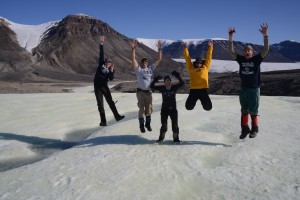Subsurface life forms that don’t need the Sun may hold the key to understanding the possibility of life elsewhere in the universe.
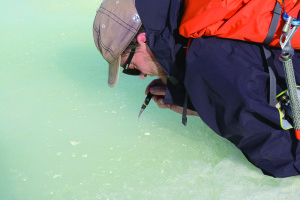
John Spear nosing around for the smell of sulfide, which can be detected by humans in amounts as small as two parts per billion.
In February 2005, a research team led by microbiologist John Spear set out to study geothermal ecosystems in the hot springs of Yellowstone National Park. What they found astonished them: microbial communities in the boiling waters were thriving not on sulfur, as was previously believed, but on hydrogen. The findings, which were published in a cover story of the Proceedings of the National Academy of Sciences (2005), provided evidence of the first hydrogen-eating microbes ever identified in an Earthly ecosystem. It may seem a minuscule advance, but it was as if an alien visitor had confirmed the existence of giraffes and could now muse about the prevalence of other possible “herbivores.”
The hydrogen-eaters Spear found ten years ago have since helped fuel a search for microbes capable of surviving in pitchblack depths, subsisting on crumbs of energy that flows from rocks exposed to water. Now, the Mines professor of civil and environmental engineering is co-leading a new five-year, $7 million NASA effort to spot evidence of such life on Mars and beyond.
Spear, who studies the habits and habitats of microbes using genetic sequencing techniques, is a co-investigator and education/public outreach lead for the new NASA Astrobiology Institute team known as ‘Rock-Powered Life.’ Led by University of Colorado Boulder geochemist Alexis Templeton, the project brings together investigators from nine institutions1 and collaborators from several others. Its aim is to narrow and refine our search for buried life elsewhere in the galaxy through a better understanding of biology here on the home planet.
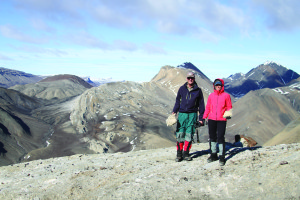
John Spear and Alexis Templeton hold samples of gypsum rock while standing on the gypsum diaper at Hare Fiord, Ellesmere Island, Canada.
For those of us who associate life with the Sun, the idea of life below the surface may take some conceptual rejiggering. As surfacedwellers, the only life we see is photosynthetic life. The autotrophs, such as plants, derive solar energy from photosynthesis; then we heterotrophs eat the plants and/or the creatures that eat the plants. But as Spear will tell you, there are vast kingdoms of microscopic life, many of them recently discovered, that don’t need the Sun at all. And that’s precisely what the NASA Astrobiology Institute and Spear’s team are looking for.
The Rock-Powered Life investigation involves a combination of field work and theory to understand the conditions in which chemolithoautotrophs (organisms that sustain themselves on energy derived from chemical changes in rock) can exist, and to identify how the very presence of these microbes alters the rocks they host. By examining the temperatures, pH levels, trace element concentrations, and energy gradients needed to support metabolism, the team hopes to identify the types of microbes and microbial communities that are undergoing the chemical processes necessary for life.
The term astrobiology may sound ‘far-out,’ but Spear’s quest will focus on deep, damp, and dark places. The team’s work will hinge on the microbes they find in serpentine rocks below sites in California, Oman, and the Atlantis Massif in the North Atlantic. Common among these three sites is a mineral called peridotite, an ultramafic rock (meaning rich in magnesium and iron) that is a mainstay on Earth, as well as in the rocky bodies of our solar system and beyond.
NASA’s interest in spending millions to shed light on buried, hydrogen- eating microbes is driven by the laws of physics and chemistry, which scientists suspect may drive universal biological forces. In particular, iron and magnesium commonly blast forth from exploding stars and unite in ultramafic rock. Where there’s enough rock and liquid water to form a habitable planet (scientists estimate there are 8.8 billon habitable planets in the Milky Way galaxy alone), all that ultramafic rock may well be providing fuel for life.
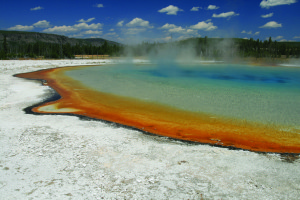
Microscopic organisms give Yellowstone
David Des Marais, a senior scientist at NASA’s Ames Research Center and longtime Astrobiology program leader, wonders if the kinds of microbes Spear’s team seeks might be among the metabolic pioneers of life on Earth. That is, maybe the photosynthetic kingdoms we’re all so familiar with were relative latecomers and our photosynthetic bias has blinded us to our own origins. These hydrogen eaters, Des Marais said, “could be indicative of our early history.”
“Maybe they’re our ancestors,” Spear adds.
For Des Marais and NASA, the Rock-Powered Life team’s insights will be most valuable in studying our russet neighbor planet, Mars. ‘Earth is the only place in the solar system whose surface environment can support life as we know it,’ said Des Marais. ‘But Mars’ early history indicates a wetter, warmer world, so perhaps life evolved at or near the surface but then persisted only in the subsurface. Everything points to the areas of investigation the Colorado team is pursuing.’
If life had indeed established a foothold on Mars, then perhaps it’s still there. In 2014, the Mars Curiosity team announced the rover had detected methane whose origins, whether microbial or chemical, came from the subsurface. “This is a significant finding, one that opens the door a bit wider for the possibility of life elsewhere,” said Spear.
John Grotzinger, former chief scientist for NASA’s Mars Curiosity mission and now chair of the Division of Geological and Planetary Sciences at the California Institute of Technology, described the team’s goal as more sharply defining the ‘environmental envelope’ of subsurface life. “The kinds of field studies and experiments the team is doing will help us fine-tune and develop a better exploration model,” he says.
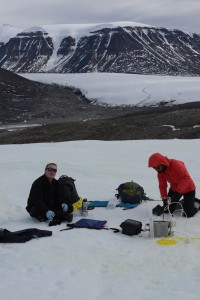
Christopher Trivedi and Alexis Templeton
The studies are particularly relevant to Mars, Des Marais added. “I expect a successful Rock-Powered Life team will help us develop a more sophisticated approach to how we would run rovers in the future, what instruments we would send, and the way we would execute the mission,” he said.
In Oman, below the Atlantic, and at the California Coast Range Ophiolite Microbial Observatory (CROMO), Spear’s team will fill mesh cylinders about the size of a cigar with crushed peridotite, obsidian, glass beads, and other rocks, and then lower the cylinders into the depths for up to a year. The depths will vary from 20 meters in California to 300 meters in Oman, with temperatures ranging from a chilly 13-18 degrees Celsius at CROMO to a near-boiling 90 degrees at the Atlantis Massif. The idea, Spear says, is to see what grows where in different environments.
Back in the lab, the painstaking work will commence, as the team inspects the rocks under scanning-electron and epifluorescent microscopes to look for cells and signs of metabolism. Next, they’ll extract DNA and use genetic sequencing techniques to assign creatures to the proper twig on the tree of life. Then it’s off to the newer techniques of modern biology, including metagenomics, etatranscriptomics, and single-cell genomics, the aim being to understand what combinations of microbes are present and how they subsist.
The metagenomics work will involve sequencing most of the DNA from the many microbes in a sample. With that, Spear says, you can infer some community traits. “Do I see hydrogenase genes, and can I infer from their presence that the community is metabolizing hydrogen? Metagenomics gives you the background in terms of what’s possible in a community,” he said.
Metatranscriptomics will look at messenger RNA to see what genes are being expressed. “It tells you not only who’s there, but who’s metabolizing and how,” Spear says.
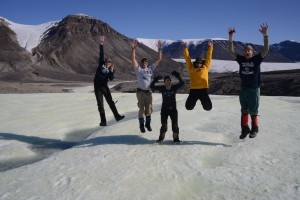
The Borup Fiord Pass Glacier Astrobiology research team (L to R): Christopher Trivedi, Steve Grasby, Alexis Templeton, Graham Lau, and John Spear.
Single-cell genomics involves isolating the DNA of an individual microbe from a community and sequencing its entire genome to provide a more thorough understanding of the microbial mass. For this step, Spear’s team will work with the Bigelow Laboratory for Ocean Sciences and the Joint Genome Institute. Spear says he wouldn’t be surprised to come across entirely new kingdoms of the tree of life.
“It’s like walking out the door and finding animals and trees for the first time,” he said.
In addition to his work in the laboratory, Spear is involved in education and public outreach efforts, such as bringing astrobiology to Native American tribal colleges and developing a ‘virtual minor’ online astrobiology course for undergraduates. The key message, he says, is that astrobiology is both far-out and not so much.
“We need to better understand us, us being this organism I call Earth,” Spear said.

